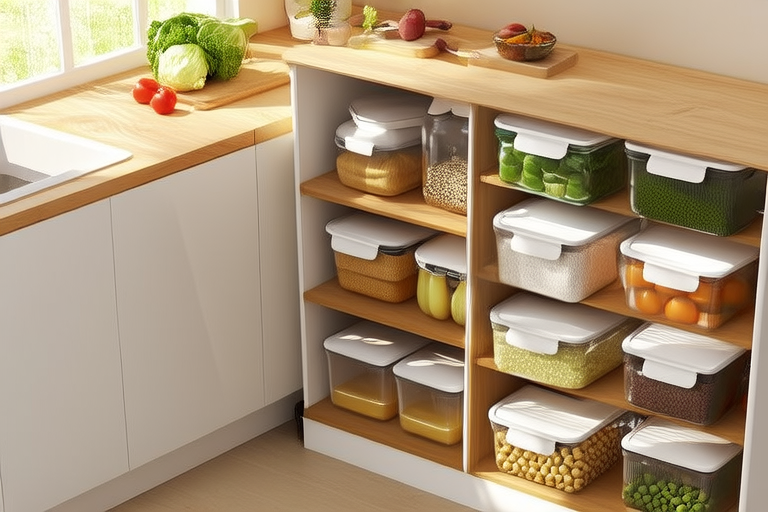How to Properly Store Your Food: Tips for Maximizing Shelf Life and Saving Money
Introduction
Proper food storage is not just about keeping your meals fresh; it’s also about saving money, reducing waste, and ensuring your health. By understanding the best practices for storing different types of food, you can extend their shelf life, maintain nutritional value, and avoid unnecessary expenses. In this article, we’ll explore various tips and techniques to help you store your food properly, from pantry staples to refrigerated items. Let’s dive in!
Understanding Temperature Zones
One of the most critical aspects of food storage is temperature control. Different foods require different environments to stay fresh and safe to eat. Here’s a breakdown of the key temperature zones:
Refrigerator Storage
The refrigerator is ideal for perishable items that need to be kept cool but not frozen. Keep the temperature between 32°F and 40°F (0°C and 4°C) to slow down bacterial growth and preserve freshness.
- Meat and Poultry: Wrap meats tightly in plastic wrap or aluminum foil before placing them in the fridge. Alternatively, use airtight containers to prevent odors from transferring.
- Dairy Products: Milk, cheese, and yogurt should be stored in the coldest part of the fridge, typically the back of the bottom shelf.
- Leftovers: Cool leftovers quickly and place them in the fridge within two hours of cooking. Use shallow containers to ensure even cooling.
Freezer Storage
Freezing is an excellent way to preserve food for extended periods. Set your freezer to 0°F (-18°C) or below to maintain quality and safety.
- Bread: Freeze bread to keep it fresh longer. Slice it before freezing if you want to thaw individual slices.
- Fruits and Vegetables: Blanch vegetables before freezing to stop enzyme activity that can degrade quality. For fruits, consider adding a little lemon juice to prevent browning.
- Soups and Stews: Freeze soups and stews in portion-sized containers for easy reheating.
Pantry Storage
A well-managed pantry can keep dry goods fresh for months. Store pantry items in a cool, dry place away from direct sunlight.
- Canned Goods: Check expiration dates and rotate stock using the “first in, first out” method.
- Grains and Pasta: Store in airtight containers to protect against pests and moisture.
- Oils and Spices: Keep oils in a dark, cool place to prevent rancidity. Spices should be stored in airtight containers away from heat and light.
Labeling and Organization
Proper labeling and organization are essential for maximizing shelf life and minimizing waste. Here’s how to do it effectively:
Label Everything
Labeling is crucial, especially for items stored in containers or jars. Include the contents, date of purchase, and any preparation instructions.
- Use stickers or markers to label cans, bottles, and containers.
- For homemade items, like soups or sauces, include the recipe details and preparation date.
Organize by Expiry Date
Organizing items by their expiry date helps you use older products first and avoid waste.
- Use clear bins or baskets to separate items based on their proximity to expiry.
- Consider using a “use me first” section for items that need to be consumed soon.
Practical Tips for Extending Shelf Life
Here are some practical tips to help you get the most out of your food storage efforts:
Vacuum Sealing
Vacuum sealing is an effective way to extend the shelf life of many foods by removing air and preventing spoilage.
- Dry Foods: Use vacuum sealing bags for grains, nuts, and dried fruits.
- Fresh Produce: Seal cut fruits and vegetables to prevent oxidation and wilting.
Dehydrating
Dehydrating removes moisture from food, which slows down bacterial growth and extends shelf life.
- Fruits and Vegetables: Dehydrate slices of apples, bananas, and bell peppers for healthy snacks.
- Herbs: Dried herbs last much longer than fresh ones and add flavor to dishes.
Canning and Pickling
Canning and pickling are traditional methods of preserving food that have stood the test of time.
- Canning: Preserve tomatoes, jams, and jellies in glass jars with proper sterilization techniques.
- Pickling: Create pickles, relishes, and fermented vegetables that can last for months.
Real-Life Case Study: A Family’s Success Story
Let’s look at how one family implemented these strategies and saw significant improvements in their food management.
The Smiths’ Journey
The Smiths were frustrated with the amount of food they were throwing away each week. After learning about proper food storage techniques, they made several changes:
- Refrigeration: They started organizing their fridge more efficiently, using shallow containers for leftovers and rotating items regularly.
- Freezing: They began freezing excess produce and preparing large batches of soups and stews.
- Pantry Management: They labeled all canned goods and rotated stock to ensure nothing expired.
Within a few months, the Smiths noticed a dramatic reduction in food waste and saved money on groceries. Their efforts paid off in both time and cost savings.
Conclusion
Proper food storage is a skill that can significantly impact your household’s budget and environmental footprint. By understanding temperature zones, labeling and organizing your storage areas, and implementing practical preservation techniques, you can maximize the shelf life of your food and reduce waste. Start by making small changes in your kitchen routine, and gradually build up your knowledge and skills. With these tips, you’ll be well on your way to a more efficient and sustainable food storage system.
Actionable Steps:
- Check your fridge and freezer temperatures to ensure they are set correctly.
- Label all containers and cans with contents and dates.
- Implement the “first in, first out” rule for pantry items.
By following these steps, you’ll not only save money but also contribute to a healthier planet by reducing food waste. Happy storing!
